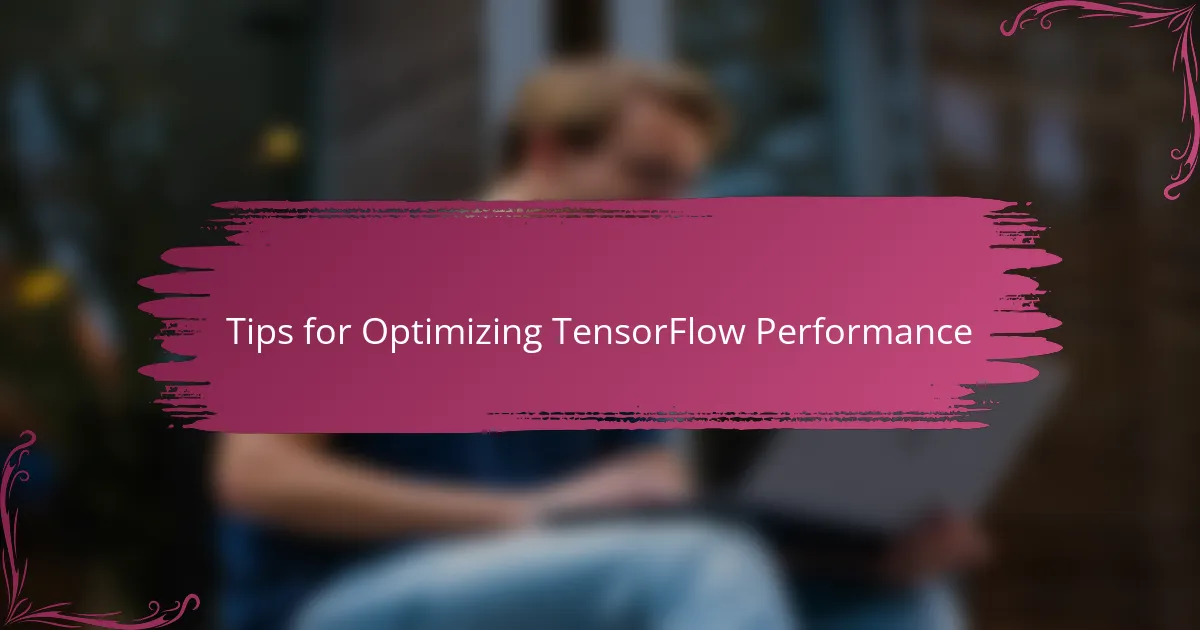Key takeaways
- TensorFlow simplifies machine learning by providing flexible libraries and intuitive APIs, making it easier for developers to implement complex neural networks.
- Setting up a virtual environment prevents version conflicts and enhances the installation process, improving the overall experience when beginning with TensorFlow.
- Understanding core concepts such as tensors and computational graphs is crucial for building and debugging models effectively, while eager execution aids in quicker learning and experimentation.
- Performance optimization techniques, like managing data pipelines and enabling mixed precision training, can significantly enhance model training efficiency without compromising accuracy.

Introduction to TensorFlow
TensorFlow is an open-source machine learning framework developed by Google that has become a go-to tool for many developers, including myself. When I first encountered it, I was amazed by its flexibility and power to handle complex neural networks with ease. Have you ever wondered how such a tool can simplify the process of building intelligent applications?
What excites me most about TensorFlow is its ability to scale from simple experiments to full production models. I remember feeling overwhelmed before, unsure how to bring my ideas to life, but TensorFlow provided a clear path forward with its comprehensive libraries and intuitive APIs. This made the learning curve feel manageable and even enjoyable.
At its core, TensorFlow works by creating dataflow graphs that represent computations. This might sound abstract at first, but once you get the hang of it, you realize it’s a brilliant way to optimize and execute complex operations efficiently. It really changed how I think about programming for AI—turning what felt like a daunting challenge into a series of logical, manageable steps.

Setting Up Your TensorFlow Environment
Setting up my TensorFlow environment was a crucial first step that I found surprisingly straightforward. I chose to work within a virtual environment to keep my project dependencies clean, which saved me from countless headaches later on. Have you ever struggled with conflicting package versions? This approach really helped me sidestep that common pitfall.
Installing TensorFlow itself was as simple as running a single pip command — pip install tensorflow — yet I was careful to verify my Python version and system compatibility beforehand. I quickly learned that small details like these can make or break your initial setup experience. It felt rewarding to see everything click into place so smoothly after a bit of preparation.
Once the installation was done, I tested it by importing TensorFlow in a simple Python script to confirm it was working properly. That moment of running the first line of code without errors gave me a confidence boost, reinforcing that I was ready to dive deeper. Don’t underestimate this small victory—it’s a great reminder that the groundwork you lay now pays off later.

Understanding Core TensorFlow Concepts
Getting a solid grasp of TensorFlow’s core concepts felt like unlocking a new level in my programming journey. I remember initially wrestling with understanding tensors—the basic data units TensorFlow operates on. Once I realized tensors are just multi-dimensional arrays carrying all kinds of data, from images to text, the fog began to lift and I felt more confident tackling models.
The idea of computational graphs was another game changer for me. At first, the idea of building graphs to represent operations seemed a bit abstract and intimidating. But then I saw how TensorFlow uses these graphs to optimize and execute tasks efficiently, breaking down complex calculations into a sequence of simple, connected steps. That shift in perspective made building and debugging models far more intuitive.
Have you ever wondered why sessions and eager execution matter? When I started, I was confused about running graphs in sessions versus executing code eagerly. Discovering that eager execution allows immediate evaluation and easier debugging was like a breath of fresh air—it transformed how I experimented with models and sped up my learning process dramatically.

Integrating TensorFlow Into Existing Projects
Integrating TensorFlow into my existing projects felt like fitting a powerful new engine into a car I already loved. At first, I worried about compatibility issues—would my current codebase mesh well with TensorFlow’s structure? It turned out that by modularizing the integration points, I could introduce TensorFlow gradually without overhauling everything at once, which made the process feel manageable rather than overwhelming.
One strategy that really helped was isolating TensorFlow-specific logic into separate components. This approach meant I could maintain my original workflow while experimenting with machine learning features bit by bit. Have you ever tried juggling too many new tools at once and felt lost? Breaking down the integration into small, testable chunks kept me grounded and confident throughout.
What surprised me most was how seamlessly TensorFlow’s APIs adapted to different programming environments. Once I wrapped my head around input pipelines and data preprocessing, plugging the model into my project’s existing data flow felt almost natural. That seamless fit gave me a sense of empowerment—I wasn’t just adding TensorFlow; I was enhancing what I already built without losing momentum.

Practical TensorFlow Coding Examples
Working with practical TensorFlow examples transformed my understanding from theory to hands-on application. For instance, building a simple image classifier using the Keras API gave me a sense of immediate accomplishment—it’s amazing how just a few lines of code can train a model to recognize objects. Have you ever felt that thrill when your code actually learns something? That moment hooked me instantly.
One project I tackled involved time series forecasting, where I experimented with LSTM networks. Initially, setting up the layers and managing data shapes felt daunting, but breaking down the problem into step-by-step code snippets helped me gain clarity. I found that seeing the predictions improve over training epochs made the effort worthwhile, turning an abstract concept into tangible results.
During another example, I integrated TensorFlow’s dataset API to build an efficient input pipeline. This was a game changer—handling large datasets with batching and shuffling not only boosted performance but also made my code cleaner. Have you ever struggled with loading data efficiently? This experience showed me that practical TensorFlow coding isn’t just about models; it’s about smooth end-to-end workflows that bring projects to life.

Troubleshooting Common TensorFlow Issues
One of the tricky moments I faced early on was dealing with version conflicts between TensorFlow and other libraries. I remember spending hours troubleshooting obscure errors that stemmed from incompatible package versions—it felt like chasing ghosts in the code. Have you ever had to sift through endless dependency issues? Pinpointing the exact mismatch and updating everything in a virtual environment finally cleared the fog for me.
Installation errors were another common hiccup. At first, I encountered weird errors related to GPU drivers or CUDA versions that left me scratching my head. It wasn’t until I meticulously checked and matched my system’s hardware capabilities with the TensorFlow requirements that I managed to get everything running smoothly. This experience taught me that patience and careful documentation reading are just as important as writing code.
Finally, debugging model training issues sometimes felt overwhelming, especially when the loss didn’t decrease or outputs were nonsense. It helped me enormously to simplify the model architecture and run tests on small datasets to isolate problems. Have you ever tried stripping down your model to catch those elusive bugs? That incremental approach turned frustration into manageable steps and kept me engaged rather than stuck.

Tips for Optimizing TensorFlow Performance
When I started optimizing TensorFlow performance, one thing that really stood out was the impact of properly managing data input pipelines. Have you ever noticed your model training slowing down because the data loading can’t keep up? Using TensorFlow’s data API to prefetch and batch data efficiently made a noticeable difference in my workflow—it felt like giving my model a faster highway to process information.
Another tip that changed the game for me was enabling mixed precision training. At first, I was hesitant, unsure if reducing numerical precision would affect accuracy. But after experimenting, I found that it significantly sped up training on compatible GPUs without sacrificing results. If your hardware supports it, this trick is like squeezing extra juice out of your system with minimal effort.
Lastly, I learned the importance of monitoring and profiling my models during training. It sounds technical, but TensorFlow’s built-in profiling tools helped me identify bottlenecks I hadn’t even suspected. Have you ever felt stuck wondering why your code wasn’t running faster? Taking the time to analyze performance metrics turned vague frustration into targeted fixes, which felt incredibly satisfying.